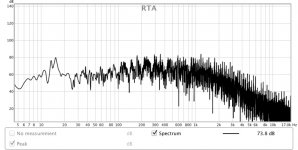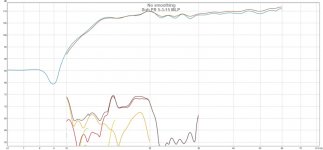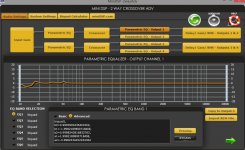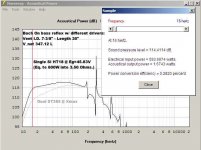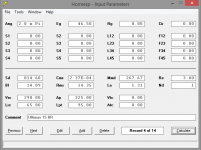I did, on both counts.
I don't feel like looking back right now, but I'm pretty sure I posed a sim, and a measurement. If I neglected the measurement and there's some challenge as to whether or not I'm fibbing about it meeting the OP's requirements, I'll take a fresh measurement tomorrow and post it.
That would be great. Looking forward to seeing the results. I didn't see it in the first 4 pages.
While waiting, there's the Grand Organ of Zurich:
PIPE ORGANS: Organ Tonhalle Zurich
a favourite of Mark's on that biggie organ, I am sure, is a weird transcription of Gnomus from ever-popular Pictures at an Exhibition, recorded very nicely, played by the resident mad-organist, Guillou.
You can see the spectrogram of the final seconds of that band below. Yup, 16 Hz.*
Ben
*I wish anybody believed that's from a mike in my music room. Alas, no. From the electric feed. Amazon has a copy for $30. Or you can join the Montreal audiophile club and ask for Disque Test CD #3, band #9.
Attachments
Last edited:
That would be great. Looking forward to seeing the results. I didn't see it in the first 4 pages.
I would do it tonight, but I plan on it being quite loud, so it'll have to wait until at least 10 am, once everyone is awake and doesn't mind me clanking doors back and forth in their frames with organ music. 😛
Ben, before I get started in a little while, is that FR you posted SPL calibrated?
Edit: Oops..does "from the electrical feed" mean that's from the line and not a speaker?
Edit: Oops..does "from the electrical feed" mean that's from the line and not a speaker?
Ben, before I get started in a little while, is that FR you posted SPL calibrated?
Edit: Oops..does "from the electrical feed" mean that's from the line and not a speaker?
Not calibrated: relative dB. Noise floor in bass for this set-up is around 0dB. I have no idea where sub-sub-sonic garbage is coming from. Quantum mechanics?
All electric.
Just to tie physics to psychology, tremendous gut-shaking growling organ bass is when the pipes are played loud around 32-40Hz. The super low pedals are perceptible only for extremely quiet, "contemplative" passages... can't 'ear 'em any other time (the Atlantic City "Boardwalk" organ may be an exception). Likewise for those tremendous thumps of the double bass for female singers: they tend to be in the 70-80Hz range.
Not that I would ever want to spoil the fun of designing-in-air a speaker to play 16Hz at 110dB.
BTW, hope you can include THD distortion in your measurements (even though it has to include mic and total system distortion). REW includes it in the trace at the click of a mouse.
Ben
Last edited:
Not calibrated: relative dB. Noise floor in bass for this set-up is around 0dB. I have no idea where sub-sub-sonic garbage is coming from. Quantum mechanics?
All electric.
BTW, hope you can include THD distortion in your measurements (even though it has to include mic and total system distortion). REW includes it in the trace at the click of a mouse.
Ben
I'm going to see if I can screen cap OmniMic's software while recording the mic into a video.
No promises, but I'm going to really try to do this in a way that presents good information.
Edit: Everyone is still asleep, except for the one early riser, which is me! It's 7:05 am right now, so give me a couple hours or so.
I bought the advanced version of TrueRTA for analysis. Someone had observed that it would be of help in my analysis. It was just short of $100. I bought the Dayton Audio EMM-6 mike and downloaded the file that is supposed to make for better calibration. It was short of $50. Got an ART USB until to provide Phantom Power and In/Out to the computer. It was like a $100.
I'm sure this isn't a top of the line package. But it will possibly give me more measurable data than just my ears. I'm still reading the TrueRTA manual. I hope to use it in better measuring the output of our bass box. It is louder with the port and the two 15" drivers. But there are spikes up and down the frequency range.
I bought this with my own money, so it didn't impact on the church budget.
I'll keep you guys posted on the output of the bass box when I get it all connected.
Bach On
I'm sure this isn't a top of the line package. But it will possibly give me more measurable data than just my ears. I'm still reading the TrueRTA manual. I hope to use it in better measuring the output of our bass box. It is louder with the port and the two 15" drivers. But there are spikes up and down the frequency range.
I bought this with my own money, so it didn't impact on the church budget.
I'll keep you guys posted on the output of the bass box when I get it all connected.
Bach On
Last edited:
Hi Bach On,
So your first try will be w/ 2ea. ST385s, and the 7-3/8"I.D. x 30"long vent. This should give you a very good idea as to where you are with your project. It's a lot of effort, but I think it will be worth it. I recommend you use a lot of fiberglass in the bottom of the enclosure. It should be far enough away from the drivers not to give you any problems, or you can use polyfill too.
When you are talking about 2ea. 18", are you talking about the UM18 or the SI18? Either driver will move enough air to overload the port, so it may take another look at that subject. (Passives anyone?)
Gotta just love it when a plan comes together.
Regards,
It's the HT18 from Stereo Integrity - I ordered the one with dual 4 ohm voice coils. They provide specs on the 2 ohm version - though not the 4 ohm version. I'm hopeful they will be very similar. This one has a 22 mm Xmax, vs. the 7.9 mm of the current woofers.
HT18 18″ Subwoofer | Stereo Integrity
I only used a small amount of fiberglass fill on the bottom and sides. I can add more or use polyfill. But I needed to get the box closed up and ready for the move.
It is a very tight fit for all those speakers in that space. Had to use vaselene, but we got them in there. Three HC12s on bottom. Three more on top. Bass speaker just to the side in a corner. Just left room enough for me to creep around and get to the connectors on the rear of the speakers.
Bach On
Some of those will be artifacts of microphone position, but many (most?) are the very real result of reflections and resonances in the loft resulting from pipe (and speaker) location. A wall reflection may enhance some notes while diminishing others in the same rank . . .But there are spikes up and down the frequency range.
Welcome to the wonderful world of regulation and voicing . . .
for the "organ impaired":
https://www.youtube.com/watch?v=qVp5hLApJQs
Digital Techniques to aid Pipe Organ Voicing and Regulation
Hokay, here we go!
First pic: Subwoofer response at mlp, volume at -20 position.
Second Pic : EQ settings used to get there.
Youtube link: Screen capture of OmniMicV2, playing last 2 minutes of Passacaglia and Fugue in C minor, BWV 582 (because that's the file I already posted the spectogram of)
Warning: Subwoofer level was increased +5 db from where it normally is, so if the video seems bass heavy, that's correct. I did that because I wanted to show SPL capability of the subwoofers, without having massive screaming pipes in my ears. Plugs can only do so much.
Edit: The sound you hear is coming directly out of the OmniMic into the video capture software.
https://www.youtube.com/watch?v=ZntIojtoeeg
Enjoy...and can we agree that my recommendation has merit? lol.
First pic: Subwoofer response at mlp, volume at -20 position.
Second Pic : EQ settings used to get there.
Youtube link: Screen capture of OmniMicV2, playing last 2 minutes of Passacaglia and Fugue in C minor, BWV 582 (because that's the file I already posted the spectogram of)
Warning: Subwoofer level was increased +5 db from where it normally is, so if the video seems bass heavy, that's correct. I did that because I wanted to show SPL capability of the subwoofers, without having massive screaming pipes in my ears. Plugs can only do so much.
Edit: The sound you hear is coming directly out of the OmniMic into the video capture software.
https://www.youtube.com/watch?v=ZntIojtoeeg
Enjoy...and can we agree that my recommendation has merit? lol.
Attachments
Last edited:
Hi Bach On,
Thanks for the additional information. Did you install the drivers front to back (as in my sketch), or both on the same baffle?
The SI HT18 has to be the current price leader. I have no personal experience with this driver, but from the simulations a single HT18 will outperform a dual ST385 in your box using the same enclosure and port dimensions. I'll attach another simulation comparing the single HT18 @ the Eg that corresponds to its rated Prms, and the dual ST385s @ Xmax. This shows the single HT18 providing clearly higher output, it does not show that the peak port velocity has doubled (to about 32m/sec); so, some of that additional output will be eaten up by turbulence in the port. As far as I'm concerned you'll need a second enclosure for the second HT18, or a much larger enclosure for both; naturally you can just stuff both into the current box, and see what you get (maybe, close of the port?).
There is so much that can be seen from the simulations, that I can only ask you to take the time to learn Hornresp:
Hornresp
There is no excuse for anyone interested in building loudspeakers not to learn at least the basics of one (or more) of the freely available simulation programs. Hornresp has the added advantage, that it provides a simple entry point into AkAbak through the Hornresp Export AkAbak Script function.
As to measuring:
The guys at cross-spectrum.com have a good reputation as to the quality of their mike calibrations. In the past the calibration files from PartsExpress had many bad reports, I don't know if they have straightened out their act. Either way, in-room measurements of subwoofers measure largely the room. But you are on the right road, you have to measure something to get data points that you can compare as the ear is notoriously unreliable at the very low frequencies.
You can spend a lot of time looking up terms like Schroeder frequency, and modal region, but I doubt if any of that will help you w/ your application. You are building a musical intrument, and the subwoofer is just one part of the range within which it is used, and an even smaller part of the whole.
I have found 1/3 octave warble tones to be much more useful than other forms of speaker excitation when trying to get a feel for the loudspeaker room interaction, and for the interaction between different loudspeakers.
And they will all interact.
Regards,
P.S.: Nice work Dr.Dyna, how do the measurements compare to a Hornresp simulation? What was the driver/enclosure/port?
Thanks for the additional information. Did you install the drivers front to back (as in my sketch), or both on the same baffle?
The SI HT18 has to be the current price leader. I have no personal experience with this driver, but from the simulations a single HT18 will outperform a dual ST385 in your box using the same enclosure and port dimensions. I'll attach another simulation comparing the single HT18 @ the Eg that corresponds to its rated Prms, and the dual ST385s @ Xmax. This shows the single HT18 providing clearly higher output, it does not show that the peak port velocity has doubled (to about 32m/sec); so, some of that additional output will be eaten up by turbulence in the port. As far as I'm concerned you'll need a second enclosure for the second HT18, or a much larger enclosure for both; naturally you can just stuff both into the current box, and see what you get (maybe, close of the port?).
There is so much that can be seen from the simulations, that I can only ask you to take the time to learn Hornresp:
Hornresp
There is no excuse for anyone interested in building loudspeakers not to learn at least the basics of one (or more) of the freely available simulation programs. Hornresp has the added advantage, that it provides a simple entry point into AkAbak through the Hornresp Export AkAbak Script function.
As to measuring:
The guys at cross-spectrum.com have a good reputation as to the quality of their mike calibrations. In the past the calibration files from PartsExpress had many bad reports, I don't know if they have straightened out their act. Either way, in-room measurements of subwoofers measure largely the room. But you are on the right road, you have to measure something to get data points that you can compare as the ear is notoriously unreliable at the very low frequencies.
You can spend a lot of time looking up terms like Schroeder frequency, and modal region, but I doubt if any of that will help you w/ your application. You are building a musical intrument, and the subwoofer is just one part of the range within which it is used, and an even smaller part of the whole.
I have found 1/3 octave warble tones to be much more useful than other forms of speaker excitation when trying to get a feel for the loudspeaker room interaction, and for the interaction between different loudspeakers.
And they will all interact.
Regards,
P.S.: Nice work Dr.Dyna, how do the measurements compare to a Hornresp simulation? What was the driver/enclosure/port?
Attachments
DrDyna's trace sure is impressive. The EQ quite minor.
What's the smoothing?
Where's the mic - listening position or up-close-and-personal with the speaker?
Is the THD 85dB down or is the scale different?
Who is next at bat?
Ben
What's the smoothing?
Where's the mic - listening position or up-close-and-personal with the speaker?
Is the THD 85dB down or is the scale different?
Who is next at bat?
Ben
DrDyna's trace sure is impressive. The EQ quite minor.
What's the smoothing?
Where's the mic - listening position or up-close-and-personal with the speaker?
Is the THD 85dB down or is the scale different?
Who is next at bat?
Ben
No smoothing, mic at MLP, about 12 feet away from mains, and about 6 feet from the subs.
Edit: The db scale in the REW screenshot is probably not entirely accurate, but the scale in the video is dead on.
P.S.: Nice work Dr.Dyna, how do the measurements compare to a Hornresp simulation? What was the driver/enclosure/port?
🙂 Thanks!
The measurements in the room are quite different from what HR predicted, there wasn't a port "hiccup" like it says, and the F3 is about 5 cycles lower, but I'm blaming that on having them jammed tight in corners. From what I can tell with my at times shaky vision, the excursion graph seems to be pretty dead on, though.
Here's the HR input screen.
It's entirely possible that some of the inputted figures aren't spot on, as this was really just a test cab to see what would happen in 13 cubes with that vent..I just happened to like them enough to not take a hammer to the cabs yet 🙂
Edit: Actually, the F3 is closer than that, now that I'm looking at the prediction harder.
Attachments
Last edited:
Hi DrDyna,
I see, that's the UM15-22 similar to 1/2 of the vented box in the other 16Hz thread. On paper I like the UM15 a lot for the very bottom end of a subwoofer, it's nice to see some confirmation.
Regards,
I see, that's the UM15-22 similar to 1/2 of the vented box in the other 16Hz thread. On paper I like the UM15 a lot for the very bottom end of a subwoofer, it's nice to see some confirmation.
Regards,
Hi DrDyna,
I see, that's the UM15-22 similar to 1/2 of the vented box in the other 16Hz thread. On paper I like the UM15 a lot for the very bottom end of a subwoofer, it's nice to see some confirmation.
Regards,
Hell yeah, they work great below 60. To be honest, I usually only have those subs engaged for movie watching (or alcohol induced techno music), for just music, the tc sounds 12s that used to be subs, I now have in my mains, which usually works very well for normal music listening down to about ~22 in room.
Edit: And when I recorded the video, I lowered the gain fully on the 12s, so it's just the big ones being heard.
Last edited:
Hi Bach On,
Thanks for the additional information. Did you install the drivers front to back (as in my sketch), or both on the same baffle?
The SI HT18 has to be the current price leader. I have no personal experience with this driver, but from the simulations a single HT18 will outperform a dual ST385 in your box using the same enclosure and port dimensions. I'll attach another simulation comparing the single HT18 @ the Eg that corresponds to its rated Prms, and the dual ST385s @ Xmax. This shows the single HT18 providing clearly higher output, it does not show that the peak port velocity has doubled (to about 32m/sec); so, some of that additional output will be eaten up by turbulence in the port. As far as I'm concerned you'll need a second enclosure for the second HT18, or a much larger enclosure for both; naturally you can just stuff both into the current box, and see what you get (maybe, close of the port?).I put them both on the same face.
Parts Express offers this one:for $95.95:
Pyle PPA18 18" 1000 Watt Premium PA Woofer
I did experiment briefly covering the port with a pillow - just for giggles. It is more solid across a wider range with the port open.
Bach On
Hi Bach On,
Post #516: "I put them both on the same face."
I was wondering about that because of your space limitations. Also good to hear that the port is helping, and that it is more solid w/ the port.
As to the Pyle PPA18, I have no basis of assuming that Pyle has started to provide correct T/S parameters. According to the one review on PE their parameters are still wildly off. I would not recommend something that cannot be simulated. Naturally, you can always buy one, and measure it, and if the measurements do not conform to the advertised parameters send it back. It would probably be best to talk to someone at PE first, they may know what the real parameters are.
The driver Dr.Dyna used, and that was used in the other 16Hz thread is a lot more expensive, but worth it:
Dayton Audio UM15-22 15" Ultimax DVC Subwoofer 2 ohms Per Coil
That driver is build for this frequency range. I saw that someone recommended a Peavey 1801-8 (in the other forum), that's another example of a driver w/ questionable T/S parameters, and if the manufacturer's values were correct it's the wrong driver for your application (I happen to have two on the shelf that did not do what they were supposed to, and that did not like the fact that someone (?) removed the high pass filter.).
Let us know how your experiments are turning out.
Regards,
Post #516: "I put them both on the same face."
I was wondering about that because of your space limitations. Also good to hear that the port is helping, and that it is more solid w/ the port.
As to the Pyle PPA18, I have no basis of assuming that Pyle has started to provide correct T/S parameters. According to the one review on PE their parameters are still wildly off. I would not recommend something that cannot be simulated. Naturally, you can always buy one, and measure it, and if the measurements do not conform to the advertised parameters send it back. It would probably be best to talk to someone at PE first, they may know what the real parameters are.
The driver Dr.Dyna used, and that was used in the other 16Hz thread is a lot more expensive, but worth it:
Dayton Audio UM15-22 15" Ultimax DVC Subwoofer 2 ohms Per Coil
That driver is build for this frequency range. I saw that someone recommended a Peavey 1801-8 (in the other forum), that's another example of a driver w/ questionable T/S parameters, and if the manufacturer's values were correct it's the wrong driver for your application (I happen to have two on the shelf that did not do what they were supposed to, and that did not like the fact that someone (?) removed the high pass filter.).
Let us know how your experiments are turning out.
Regards,
No smoothing, mic at MLP, about 12 feet away from mains, and about 6 feet from the subs.
Edit: The db scale in the REW screenshot is probably not entirely accurate, but the scale in the video is dead on.
Since DrDyna is the only person proud enough of their system to post measurements and since it bears a good resemblance to OP's inquiry and since it looks great, I guess his system becomes the benchmark for Bach On.
Therefore.... it sure would be nice to have some better definition of the test conditions.
To my impaired understanding of these things, the mic is sort-of near-field in a special room or space with no detectable modes. But assuming the THD really isn't -85dB (with -40dB or 1% being a good achievement for earth-bound loudspeakers), we really need a better understanding of the scale to form any reliable impression of the freq response or THD performance.
Thanks.
Ben
Since DrDyna is the only person proud enough of their system to post measurements and since it bears a good resemblance to OP's inquiry and since it looks great, I guess his system becomes the benchmark for Bach On.
Therefore.... it sure would be nice to have some better definition of the test conditions.
To my impaired understanding of these things, the mic is sort-of near-field in a special room or space with no detectable modes. But assuming the THD really isn't -85dB (with -40dB or 1% being a good achievement for earth-bound loudspeakers), we really need a better understanding of the scale to form any reliable impression of the freq response or THD performance.
Thanks.
Ben
Sort of near field, yes. Around 6 feet away from where the mic sits, which I have on a stand. It sits straight up in the air where I normally park my butt. When I take measurements with OnmiMic to generate biquads for the MiniDSP, I sit with the microphone just above my head while I'm slinked into the couch, and with one hand I move the microphone around in a 3d area about twice the size of a basketball, while clicking on "more averages" inside OmniMic. That's where the correction filters come from, I let it do all that stuff automagically, and it's pretty good at it.
Yeah, the distortion is low in the FR plot, but that plot was taken with the volume knob at -20, and REW's measurement generator (which I use after I'm done with OmniMic, as I just think REW is prettier.) sits by default at like -12, so it's really not that loud. It's actually just slightly higher than my perception of the tones it's generating.
So, I would expect that the distortion is more or less in line with what you'd expect a pair of 15" woofers to be when I go from -12 rew sweep with the volume at -20 to the media player at full tilt and the receiver volume..uh, up around -4? when I recorded the video?
I can re-do another distortion graph and try to calibrate rew's chart to match omnimics, which I just haven't done because it hadn't mattered, I didn't need both pieces of software to be spl calibrated.
INBD though, I'll try to do it tomorrow, if you are genuinely curious to see what the distortion really is, but I'd imagine it's probably right where you'd expect it to be, starting it's journey through double digits.
I hold my mic in a camera tripod (almost like on my head!). After vast efforts to find one, I ended up machining my own mic-stand to camera-tripod adapter from a half-inch NF bolt.
For sure, speaker distortion is extravagant with large motions (good reason to like horns) but at small loudness not ever as low as -85dB (which would be great home-brew measurement for an amp).* Likewise for the big bump-up in distortion in the vicinity of bass-reflex tuning which possibly should read -20dB (10% THD) to -25dB - and yet it wouldn't even be noticed on organ music.
Any averaging in the traces?
Ben
*You may hear snickering from my friends with ESLs whose distortion is materially lower than with shaking-cardboard drivers.
For sure, speaker distortion is extravagant with large motions (good reason to like horns) but at small loudness not ever as low as -85dB (which would be great home-brew measurement for an amp).* Likewise for the big bump-up in distortion in the vicinity of bass-reflex tuning which possibly should read -20dB (10% THD) to -25dB - and yet it wouldn't even be noticed on organ music.
Any averaging in the traces?
Ben
*You may hear snickering from my friends with ESLs whose distortion is materially lower than with shaking-cardboard drivers.
Last edited:
- Status
- Not open for further replies.
- Home
- Loudspeakers
- Subwoofers
- 16Hz for church organ
